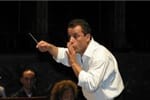This concert by the Nice Philharmonic Orchestra under the direction of Marco Guidarini was exceptional this Saturday, February 28, in more ways than one: firstly, it had been some weeks, in fact since the opening of the Nice lyrical season with “Macbeth” and the concert dedicated to Shostakovich’s Symphony No. 7, that the Musical Director had not taken his place in the Opera pit. Additionally, due to the program, two pieces were presented as the culmination of symphonic work by composers often associated with each other. Both due to their proximity in time but also because there was between the two a quasi-Hegelian dialectic of master and pupil. Wolfgang Amadeus Mozart’s Symphony No. 38, known as “Prague” and Franz Joseph Haydn’s Symphony 104, known as “London” are both pieces of high-level musical architecture. This makes the discussion of their interpretation all the more challenging.
As usual, Marco Guidarini does not shrink from the demands of rigorous, meticulous, and often intellectualized conducting. Each movement seems to have been studied, dissected, and deepened in its latent meanings. Undoubtedly inspired by his discoveries, the Maestro clearly wishes to share with the public the fruits of his reflections. To the point of risking an approach that is sometimes a bit scholastic, learned, almost too “scholarly”. Indeed, this corresponds in Mozart’s work to that “serious interiority”, at least in the slow introduction, not majestic by power but by those successive steps and regular gradations suggested by the harmonic sequences and delicately punctuated by the harpsichord at each crossing. In these sequences, many exegetes have sought to detect the solemnity filled with the concentration of a ritual Masonic opening. Some regulars might find enigmatic resemblances with melodic accents from “Don Giovanni” or “The Magic Flute.”
A considerable sense of strangeness was reinforced by an orchestra in reduced formation: the number of musicians Haydn had to play his Symphony No. 104 in 1795 approached 65, while Nice had barely forty that evening. This sometimes gave the impression of encountering a chamber musical discourse, with proportions limited and reserved only for the fortunate members of an 18th-century salon.
Marco Guidarini more easily satisfies his desire for control in the second movement of Mozart’s 38th Symphony, characterized by discretion, a kind of melodic effacement, where nevertheless continues to manifest the mixture of the two themes that animate this work. A mastery, however, more complex to continue in the other two movements where the conductor seems to hold back, restrain the spontaneous impulses of his orchestra. After all, he is the conductor. But this direction by the Maestro suggests that it ultimately limits the personal interpretive space of the musicians.
Between the two, a “break”, if you will, as the program offered Francis Poulenc’s Piano Concerto from 1949: a humorously musical piece as it reminds one simultaneously of a movie trailer but also a very enjoyable piece fed by evident talents in orchestration and an original play of tonalities on the same theme. In this piece, Poulenc arranges classical string harmonies, abruptly interrupted by a punctuation as brief as it is intense from the brass. The composer enjoys himself to such an extent that although one acknowledges and respects the seriousness and involvement of the musicians and the conductor, one smiles! Fantastic psychological effects of this very particular music where quality rather than quantity of piano intervention predominates: winner of numerous international competitions, a specialist in the Romantic repertoire – his five volumes of “Complete Schumann” have been widely praised by critics – Eric Le Sage clearly enjoys himself. A sensation widely shared with the audience who loudly called for an encore. To no avail. A doctoral evening to the end.


